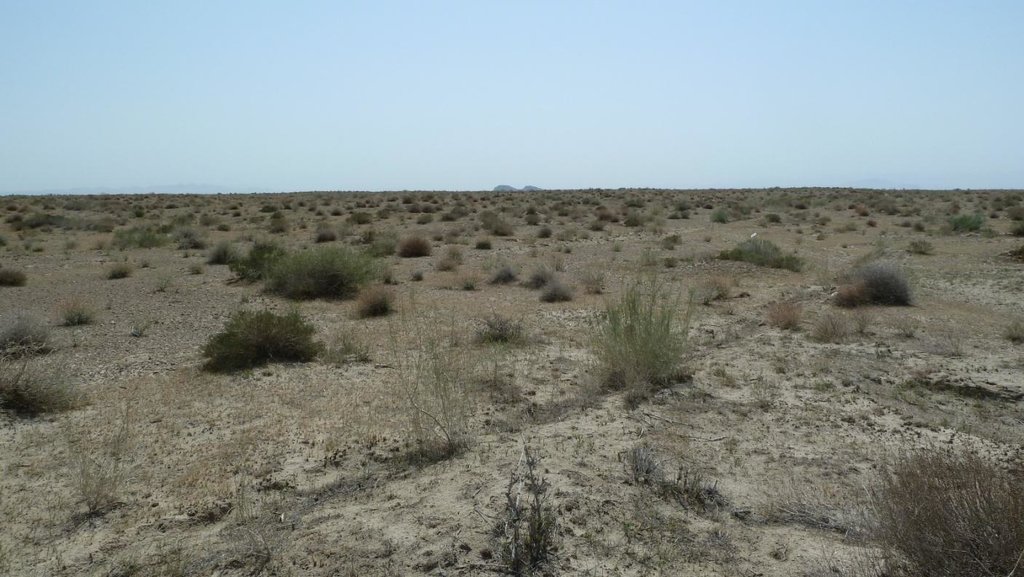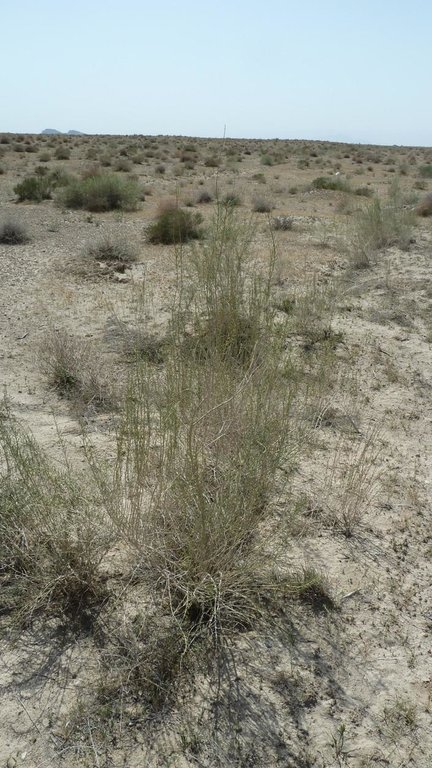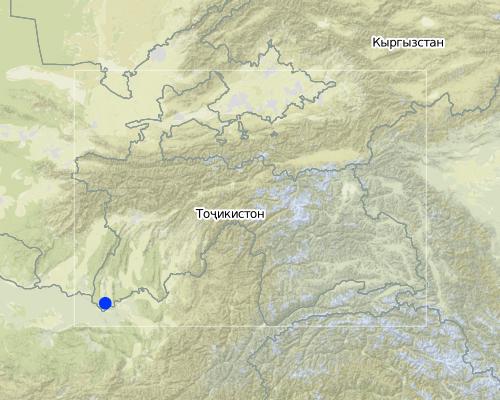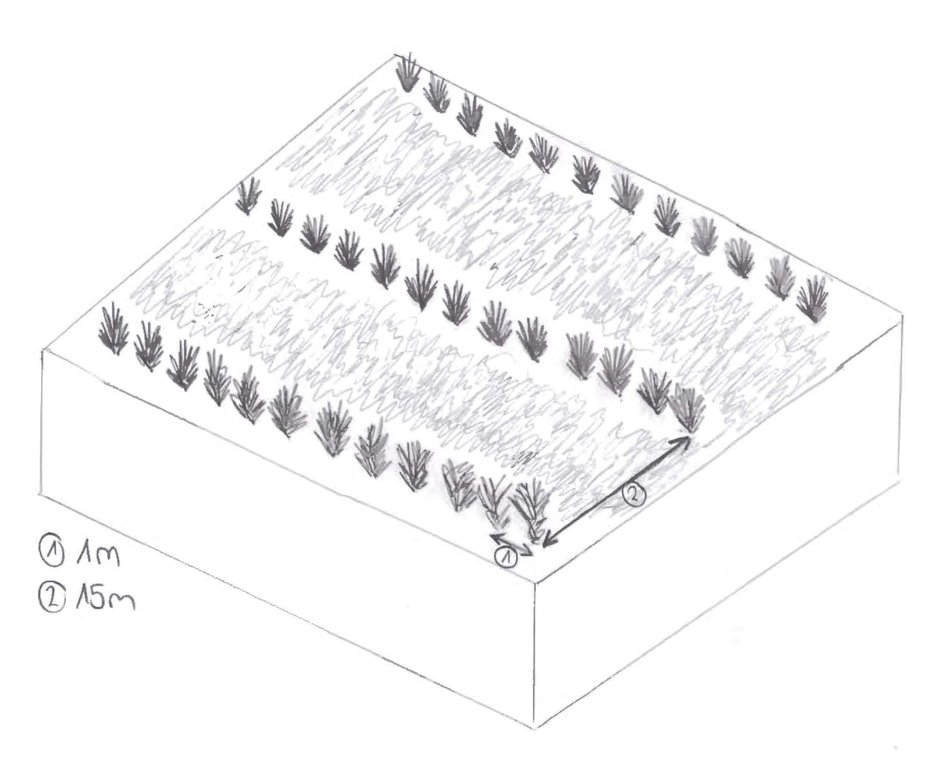Saxaul plantation for stabilisation of sandy soils [Tajikistan]
- Creation:
- Update:
- Compiler: Firdavs Faizulloev
- Editor: –
- Reviewer: David Streiff
technologies_1461 - Tajikistan
View sections
Expand all Collapse all1. General information
1.2 Contact details of resource persons and institutions involved in the assessment and documentation of the Technology
SLM specialist:
SLM specialist:
SLM specialist:
Najmiddin Abdurakhimov
najmiddin.abdurakhimov@undp.org
UNDP
Tajikistan
Name of the institution(s) which facilitated the documentation/ evaluation of the Technology (if relevant)
CDE Centre for Development and Environment (CDE Centre for Development and Environment) - SwitzerlandName of the institution(s) which facilitated the documentation/ evaluation of the Technology (if relevant)
Central Asian Countries Initiative for Sustainable Land Management - Multicountry Capacity Building (CACILM - MCB) - KyrgyzstanName of the institution(s) which facilitated the documentation/ evaluation of the Technology (if relevant)
United Nations Development Program (United Nations Development Program) - Tajikistan1.3 Conditions regarding the use of data documented through WOCAT
When were the data compiled (in the field)?
13/04/2011
The compiler and key resource person(s) accept the conditions regarding the use of data documented through WOCAT:
Yes
2. Description of the SLM Technology
2.1 Short description of the Technology
Definition of the Technology:
Saxaul (Haloxylon ammodendron) bushes are planted on denuded sandy soils with the aim to reduce the rate of desertification.
2.2 Detailed description of the Technology
Description:
On 15 ha of denuded land, prone to wind erosion the Saxaul bush (Haloxylon ammodendron) which is native to Central Asia was planted in order to stabilise the soils and halt desertification. Over two years 25 ha of Saxaul plantation was established through natural spreading of the plant. The idea came from UNDP who also funded the purchase of seeds, fuel and fertilisers. UNDP further conducted an awareness raising campaign among local land users and members of dekhkan farms about the role of Saxaul bushes in combating land degradation and techniques of planting Saxaul plantations.
Purpose of the Technology: The Shaartuz area has repeatedly suffered from droughts, and the natural vegetation cover is highly degraded due to overexploitation for firewood. This renders the sandy soils very susceptible to wind erosion. Saxaul plantations have been widely applied in other arid areas of Central Asia to combat desertification, and were selected as an appropriate method for soil fixation around Shaartuz.
Establishment / maintenance activities and inputs: Saxaul seeds have to be collected in November, and need to be planted immediately, as otherwise they lose their viability. A tractor was used to plough the land, and the seeds were planted manually. 15 ha of plantation were planted in one single day. As they are not irrigated in this area, the Saxaul bushes are entirely dependent on winter rain and dew for their water supply. The trees grow slowly and need protection from roaming cattle. As the forestry department (leskhoz) responsible for the protection of the plantation has no guards, the project employed a local forester from the Jamoat to protect the area. Meetings were held with surrounding villages to discuss the risk of wind erosion, and the need for the plantations. Also a mobile theatre was involved in order to raise the public awareness with regards to deforestation and desertification issues. An agreement was achieved with the local residents to help protect the newly planted trees from cattle.
Natural / human environment: Saxaul plantations improve vegetation cover, and therefore also increase water infiltration into the soil and improve soil structure. Once the soil has stabilised with the help of the Saxaul bushes, other herbs and bushes will regenerate in the area, and reinforce the vegetation cover. Moreover, different wild animals and birds are already nesting in the area as the vegetation increases.
2.3 Photos of the Technology
2.5 Country/ region/ locations where the Technology has been applied and which are covered by this assessment
Country:
Tajikistan
Region/ State/ Province:
Shaartuz, Khatlon
Further specification of location:
Jura Nazarov Jamoat
Map
×2.6 Date of implementation
If precise year is not known, indicate approximate date:
- less than 10 years ago (recently)
2.7 Introduction of the Technology
Specify how the Technology was introduced:
- through projects/ external interventions
Comments (type of project, etc.):
2009
3. Classification of the SLM Technology
3.1 Main purpose(s) of the Technology
- reduce, prevent, restore land degradation
3.2 Current land use type(s) where the Technology is applied

Grazing land
Extensive grazing land:
- Semi-nomadism/ pastoralism

Forest/ woodlands
Products and services:
- Nature conservation/ protection
Comments:
Major land use problems (compiler’s opinion): removal of natural vegetation cover, loss of topsoil through wind erosion
Major land use problems (land users’ perception): wind erosion, droughts,
Plantation forestry: Yes
Forest products and services: nature conservation / protection
Future (final) land use (after implementation of SLM Technology): Forests / woodlands: Fp: Plantations, afforestations
If land use has changed due to the implementation of the Technology, indicate land use before implementation of the Technology:
Grazing land: Ge: Extensive grazing land
3.3 Further information about land use
Number of growing seasons per year:
- 1
Specify:
Longest growing period in days: 240Longest growing period from month to month: March-October
3.4 SLM group to which the Technology belongs
- windbreak/ shelterbelt
- improved ground/ vegetation cover
- improved plant varieties/ animal breeds
3.5 Spread of the Technology
Comments:
Total area covered by the SLM Technology is 0.15 m2.
3.6 SLM measures comprising the Technology

vegetative measures
- V1: Tree and shrub cover
Comments:
Main measures: vegetative measures
Type of vegetative measures: aligned: -linear
3.7 Main types of land degradation addressed by the Technology

soil erosion by wind
- Et: loss of topsoil
- Ed: deflation and deposition

biological degradation
- Bc: reduction of vegetation cover
- Bh: loss of habitats
- Bq: quantity/ biomass decline
Comments:
Main type of degradation addressed: Et: loss of topsoil, Ed: deflation and deposition, Bc: reduction of vegetation cover
Secondary types of degradation addressed: Bh: loss of habitats, Bq: quantity / biomass decline
Main causes of degradation: over-exploitation of vegetation for domestic use, overgrazing
Secondary causes of degradation: droughts, population pressure (high demand for firewood)
3.8 Prevention, reduction, or restoration of land degradation
Specify the goal of the Technology with regard to land degradation:
- reduce land degradation
- restore/ rehabilitate severely degraded land
Comments:
Main goals: rehabilitation / reclamation of denuded land
Secondary goals: mitigation / reduction of land degradation
4. Technical specifications, implementation activities, inputs, and costs
4.1 Technical drawing of the Technology
4.2 Technical specifications/ explanations of technical drawing
Saxaul seeds are planted in parallel rows, with 15 m spacing between each row. The interval between seeds within each row is 1m.
Location: Jura Nazarov Jamoat. Shaartuz, Khatlon
Date: 27.05.2011
Technical knowledge required for field staff / advisors: low
Technical knowledge required for land users: low
Main technical functions: improvement of ground cover, stabilisation of soil (eg by tree roots against land slides)
Secondary technical functions: increase of infiltration, reduction in wind speed, increase of biomass (quantity)
Aligned: -linear
Vegetative material: T : trees / shrubs
Number of plants per (ha): 667
Spacing between rows / strips / blocks (m): 15
Vertical interval within rows / strips / blocks (m): 1
Trees/ shrubs species: Saxaul (Haloxylon ammodendron)
4.3 General information regarding the calculation of inputs and costs
other/ national currency (specify):
Somoni
Indicate exchange rate from USD to local currency (if relevant): 1 USD =:
4.5
Indicate average wage cost of hired labour per day:
5.50
4.4 Establishment activities
| Activity | Type of measure | Timing | |
|---|---|---|---|
| 1. | Collect Saxaul seeds | Vegetative | November |
| 2. | Plant seeds using tractor with automated seed planter | Vegetative | December |
| 3. | Application of carbamide fertiliser once after planting seeds | Vegetative | December |
4.5 Costs and inputs needed for establishment
| Specify input | Unit | Quantity | Costs per Unit | Total costs per input | % of costs borne by land users | |
|---|---|---|---|---|---|---|
| Labour | Collect Saxaul seeds | Persons/day | 16.0 | 20.0 | 320.0 | 100.0 |
| Equipment | Tractor for seed planting | Persons/day | 1.0 | 100.0 | 100.0 | 100.0 |
| Equipment | Fuel | ha | 15.0 | 6.666666 | 100.0 | |
| Plant material | Seeds | kg | 13.0 | 15.0 | 195.0 | |
| Fertilizers and biocides | Fertilizer | kg | 3.3 | 2.42424242 | 8.0 | |
| Total costs for establishment of the Technology | 723.0 | |||||
If land user bore less than 100% of costs, indicate who covered the remaining costs:
UNDP
4.6 Maintenance/ recurrent activities
| Activity | Type of measure | Timing/ frequency | |
|---|---|---|---|
| 1. | Protection of plantation from roaming cattle by local forestry employee | Vegetative | ongoing |
4.7 Costs and inputs needed for maintenance/ recurrent activities (per year)
| Specify input | Unit | Quantity | Costs per Unit | Total costs per input | % of costs borne by land users | |
|---|---|---|---|---|---|---|
| Labour | Protection of plantation from cattle | ha/month | 15.0 | 16.666667 | 250.0 | |
| Total costs for maintenance of the Technology | 250.0 | |||||
Comments:
Machinery/ tools: tractor with automated seed planter
Costs for the purchase of seeds and fertilisers were calculated for one ha of plantation.
However, the costs indicated for machinery and labour regarding the seed collection and planting process are with respect to the whole plantation of 15 ha.
The costs for labour during maintenance are for the monthly salary of an employee who is needed to protect the plantation from outsiders.
4.8 Most important factors affecting the costs
Describe the most determinate factors affecting the costs:
For this technology, costs are related to the use of a tractor for planting of seeds and for the purchase of seeds and fertiliser. As the plantation was implemented by the forestry agency, labour used was provided by current employees of the agency.
5. Natural and human environment
5.1 Climate
Annual rainfall
- < 250 mm
- 251-500 mm
- 501-750 mm
- 751-1,000 mm
- 1,001-1,500 mm
- 1,501-2,000 mm
- 2,001-3,000 mm
- 3,001-4,000 mm
- > 4,000 mm
Specify average annual rainfall (if known), in mm:
100.00
Agro-climatic zone
- arid
Thermal climate class: temperate
5.2 Topography
Slopes on average:
- flat (0-2%)
- gentle (3-5%)
- moderate (6-10%)
- rolling (11-15%)
- hilly (16-30%)
- steep (31-60%)
- very steep (>60%)
Landforms:
- plateau/plains
- ridges
- mountain slopes
- hill slopes
- footslopes
- valley floors
Altitudinal zone:
- 0-100 m a.s.l.
- 101-500 m a.s.l.
- 501-1,000 m a.s.l.
- 1,001-1,500 m a.s.l.
- 1,501-2,000 m a.s.l.
- 2,001-2,500 m a.s.l.
- 2,501-3,000 m a.s.l.
- 3,001-4,000 m a.s.l.
- > 4,000 m a.s.l.
5.3 Soils
Soil depth on average:
- very shallow (0-20 cm)
- shallow (21-50 cm)
- moderately deep (51-80 cm)
- deep (81-120 cm)
- very deep (> 120 cm)
Soil texture (topsoil):
- coarse/ light (sandy)
Topsoil organic matter:
- low (<1%)
If available, attach full soil description or specify the available information, e.g. soil type, soil PH/ acidity, Cation Exchange Capacity, nitrogen, salinity etc.
Soil fertility is low
Soil drainage / infiltration is good
Soil water storage capacity is very low
5.4 Water availability and quality
Ground water table:
> 50 m
Availability of surface water:
poor/ none
Water quality (untreated):
poor drinking water (treatment required)
Comments and further specifications on water quality and quantity:
Water quality (untreated) is poor and groundwater
5.5 Biodiversity
Species diversity:
- low
5.6 Characteristics of land users applying the Technology
Market orientation of production system:
- commercial/ market
Individuals or groups:
- employee (company, government)
Indicate other relevant characteristics of the land users:
Difference in the involvement of women and men: forestry agency
Annual population growth: 1% - 2%
Off-farm income specification: It is not the land users who apply the technology, but forestry agency employees.
Market orientation of production system: only protection function
5.8 Land ownership, land use rights, and water use rights
Land ownership:
- state
Land use rights:
- communal (organized)
5.9 Access to services and infrastructure
health:
- poor
- moderate
- good
education:
- poor
- moderate
- good
technical assistance:
- poor
- moderate
- good
employment (e.g. off-farm):
- poor
- moderate
- good
markets:
- poor
- moderate
- good
energy:
- poor
- moderate
- good
roads and transport:
- poor
- moderate
- good
drinking water and sanitation:
- poor
- moderate
- good
financial services:
- poor
- moderate
- good
6. Impacts and concluding statements
6.1 On-site impacts the Technology has shown
Socio-economic impacts
Production
production area
Comments/ specify:
Loss of grazing land due to restricted access, however, land was already degraded.
Income and costs
expenses on agricultural inputs
Comments/ specify:
Fertilisers are needed during the establishment phase
workload
Comments/ specify:
A guard is needed to protect the plantation all day long from roaming cattle.
Ecological impacts
Water cycle/ runoff
evaporation
Soil
soil cover
soil loss
Biodiversity: vegetation, animals
biomass/ above ground C
habitat diversity
Comments/ specify:
provides a habitat for a bird species that are dependent on the tree (Passer ammodendri)
Climate and disaster risk reduction
wind velocity
6.2 Off-site impacts the Technology has shown
wind transported sediments
6.3 Exposure and sensitivity of the Technology to gradual climate change and climate-related extremes/ disasters (as perceived by land users)
Gradual climate change
Gradual climate change
| Season | Type of climatic change/ extreme | How does the Technology cope with it? | |
|---|---|---|---|
| annual temperature | increase | well |
Climate-related extremes (disasters)
Meteorological disasters
| How does the Technology cope with it? | |
|---|---|
| local rainstorm | well |
| local windstorm | well |
Climatological disasters
| How does the Technology cope with it? | |
|---|---|
| drought | well |
Hydrological disasters
| How does the Technology cope with it? | |
|---|---|
| general (river) flood | not well |
Other climate-related consequences
Other climate-related consequences
| How does the Technology cope with it? | |
|---|---|
| reduced growing period | well |
6.4 Cost-benefit analysis
How do the benefits compare with the establishment costs (from land users’ perspective)?
Short-term returns:
neutral/ balanced
Long-term returns:
positive
How do the benefits compare with the maintenance/ recurrent costs (from land users' perspective)?
Short-term returns:
neutral/ balanced
Long-term returns:
positive
6.5 Adoption of the Technology
If available, quantify (no. of households and/ or area covered):
NA
Of all those who have adopted the Technology, how many have did so spontaneously, i.e. without receiving any material incentives/ payments?
- 0-10%
Comments:
Comments on acceptance with external material support: the technology was implemented by the forestry agency, not the land users
There is a little trend towards spontaneous adoption of the Technology
Comments on adoption trend: Farmers have understood the importance of Saxaul plantations, and the role Saxaul bushes can play in combating sand drifts. There has been a trend towards growing spontaneous adoption of the technology by others.
6.7 Strengths/ advantages/ opportunities of the Technology
| Strengths/ advantages/ opportunities in the compiler’s or other key resource person’s view |
|---|
|
Effective fixation of sandy soils, protecting them from wind storms and preventing erosion. How can they be sustained / enhanced? Increase plantation areas in the region |
| Use of native tree species which are very well adapted to arid ecosystems |
| Through the plantation of Saxaul, the establishment of other plant species follows on naturally. |
6.8 Weaknesses/ disadvantages/ risks of the Technology and ways of overcoming them
| Weaknesses/ disadvantages/ risks in the land user’s view | How can they be overcome? |
|---|---|
| Decline of areas suitable for cattle grazing | Developing a management plan which could include restricted user rights for cattle grazing |
| Weaknesses/ disadvantages/ risks in the compiler’s or other key resource person’s view | How can they be overcome? |
|---|---|
| The plantation only has protective function, but there is no aim to introduce a sustainable management scheme which would allow for the extraction of firewood. | Develop a management plan |
| The area covered by the plantation is very small so the impacts might be minimal. | Increase the plantation area |
Links and modules
Expand all Collapse allLinks
No links
Modules
No modules






